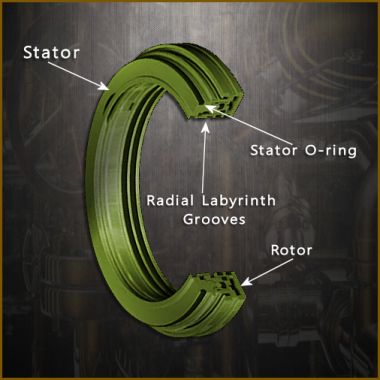Abradable Polymer Labyrinth Seals
Abradable polymer labyrinth seals are a mechanical, dynamic seal based on the original labyrinth seal, but with a curious twist that increases efficiency. They can be made of different materials, but in this post we are going to focus on polymer labyrinth seals, and, more specifically, on modified PTFE abradable polymer labyrinth seals. Here are five fascinating facts about abradable polymer labyrinth seals, starting with some basic facts of abradable labyrinth seals:




 what material to use for the lip. Most rotary shaft seals have a lip that is made of a thermoplastic (such as PTFE, PP, or PVC), an elastomer (natural or synthetic rubber), a thermoplastic elastomer (for example, PE), or a metal. In this post, we are going to look at what makes PTFE a competitive choice for a metal-cased rotary lip seal by investigating six things your competitors dont want you to know.
what material to use for the lip. Most rotary shaft seals have a lip that is made of a thermoplastic (such as PTFE, PP, or PVC), an elastomer (natural or synthetic rubber), a thermoplastic elastomer (for example, PE), or a metal. In this post, we are going to look at what makes PTFE a competitive choice for a metal-cased rotary lip seal by investigating six things your competitors dont want you to know. The primary purpose of a typical expansion bellows is to isolate a fluid from neighboring components. Bellows are used in a variety of applications, including pulse dampeners, HVAC systems, pharmaceutical processing, pollution control, and piping systems.
The primary purpose of a typical expansion bellows is to isolate a fluid from neighboring components. Bellows are used in a variety of applications, including pulse dampeners, HVAC systems, pharmaceutical processing, pollution control, and piping systems. 
 destroy an otherwise successful company. It is vital that the equipment be not only reliable but compliant with governmental regulations. More and more engineers are turning to polymer options in the design and implementation of food and dairy processing equipment. This post will focus on why polymers are an outstanding option for a specific aspect of machinery used in these industries: bushings.
destroy an otherwise successful company. It is vital that the equipment be not only reliable but compliant with governmental regulations. More and more engineers are turning to polymer options in the design and implementation of food and dairy processing equipment. This post will focus on why polymers are an outstanding option for a specific aspect of machinery used in these industries: bushings.

